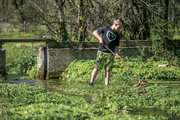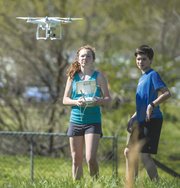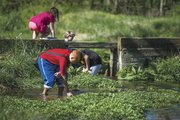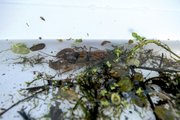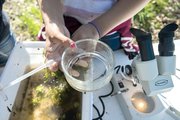Collecting data doesn't have to be boring -- a lesson learned by citizen scientists from the EAST program at J.O. Kelly Middle School in Springdale. The sixth- and seventh-graders waded in on an early April morning, using nets, trays and more to capture mud puppies, various species of flies and a respectable number of crawfish.
The students gathered some of the earliest documentation of the condition of the stream at Steele-Stevens Heritage Park in downtown Elm Springs. Children called out and splashed in the creek, a GoPro camcorder documented the rushing water, and a drone buzzed above the site formed by the springs that gave the town its name.
Elm Spring
Pioneer Days
When: 11 a.m. to 4:30 p.m. May 14
Where: Steele-Stevens Heritage Park, on Water Street downtown
Activities: Park dedication at 4 p.m.; Marshall Mitchell at 11 a.m. to 1 p.m.; Tommy Wildcat, Cherokee flutist from 2 to 4 p.m.; farm and homestead exhibits; food vendors; costumed pioneer characters; pottery demonstration.
Presented by: Elm Springs Historical Society and Heritage Center
Information: 601,3803, historices@gmail.com, historicelmsprings.….
Water bear
Scientific name: Tardigrade
Dated to: 530 million years ago
Length: 0.5 to 1.5 mm
Description: Short and plump, with four pairs of legs, each with four to eight claws; segmented bodies.
Habitat: Typically on mosses in wet environments world wide
Feed: Plant cells, algae, small invertibrates.
Grouping: Previously grouped with arthropods (insects, spiders, crabs). Now classed as its own group.
Discoveries: Can survive extreme temperatures to 304 degrees Fahrenheit and - 458 degrees Fahrenheit, atmospheric pressure greater thatn six times found in deepest oceans, in the vacuum of outer space, ultraviolet radiation, cosmic radition, 30 years without food or water.
SOURCE: Nature World News
"Right there! Right there! I caught something! I caught something!" Miguel Ulloa called excitedly as he brought a tray up the creek bank to a table equipped with microscopes.
"Use the pipette to sneak up behind him," instructed Floyd Watson, telling students how to pull the tiny organisms from the water in the tray, and helping them make correct identifications.
"This is a real one," Watson said. "What will it grow up to be?"
"That's an aquatic worm," said Jesse Alcala. "And we have a crane fly."
The team of four boys counted a minnow, two crawfish and a baby salamander in their tray, which they filled while "wading through the weeds."
"You also have some water cress and common water moss," Watson told them. "Y'all have critters in there, too. You'll have to look really close."
BASELINE NEEDED
Watson retired several years ago after 33 years as a teacher and director of environmental studies for Springdale Public Schools. He taught many children about water environments as their classes traveled to the Lake Fayetteville Aquatic Center for hands-on lessons. Today, Watson owns and operates a construction company.
Calling on his experience, Anita Burney, executive director of the Elm Springs Historical Society, asked him for input in to rejuvenating the creek area for park visitors.
Watson knew immediately he could improve the creek with riparian projects, "making each side of the bank naturally beautiful," he said. "It will look pleasing, but it also will be natural. It will protect what's in and around the stream -- the plants and animals it supports."
He also suggested putting rocks along the entire bank, so people could sit, and redesigning the spring house with natural rock, "so it looks like the stream is coming out of the bank," he said.
But before he made any concrete plans, Watson needed to know more about the stream, so construction won't damage the habitat. "We need to know what's here, the current state of the stream. Is it healthy? I think it's a really healthy stream," he said.
But he also needed help with that project. After a chance reunion with Watson as a substitute bus driver and EAST teacher Susan Tillery, her students started the project. "Teaching about the environment has always been my first love," Watson said.
Watson visited the school and the 45 students involved in the project to coach them in advance on their task. He explained the three distinct water habitats they would find in the Elm Springs stream -- a waterfall, riffling water over rocks and slow-flowing water. He described and showed pictures of organisms they might find and explained the process of collection.
"And what 12-year-old doesn't want to be in the creek?" Tillery asked.
"Going into the creek is an adventure because of all the things you'll discover," said student Amavelin Barrientos.
"You have to be careful," added Samantha Davis, "because some of these creatures, you can squish them."
IN THE LAB
Back in the EAST classroom at J.O. Kelly, the students -- who were divided into biological survey teams, a GIS mapping team and a video and photography team -- continued their work.
Ian Gelicame sat at a computer practicing a technique he would use later in the documentation of the stream. Tillery explained the team used cell phones at the site, taking pictures of the various organisms students found. Then, the teacher and students would walk to the stream habitat and, through an app, record GPS coordinates for the find. Later, these sites, with pictures, will be pinpointed on a map, which could then be searched through many layers, such as habitat type, organism type or even season.
"We can study the things we find, and go back and find them again," Gelicame said.
William Magana, Anthony Osorio, Moises Roman and Hayden Boyd, making up one of the biological survey teams, sat across the room at another bank of computers. They were adding data from their identification journals to a spread sheet which included the common name of the species, a description, the scientific name and a description of the location where it was found, Magana explained.
"Amphibians and fish, macroinvertibrates -- which can have either shells or no shells or legs -- and algae," Osorio listed categories.
"We found rainbow darter and duck weed -- it was really easy to find," Boyd continued. "We found star moss on a bunch of rocks, and a common moss in the waterfall. And we found this reddish darter -- Mr. Watson is looking for its name."
"There are so many darters, I can't ID them all without a book," Watson admitted.
In addition to what they learned, the students discovered more they needed to learn.
Chloe Crane and Ryan Espejo spent their day at the park operating the drone carrying a camera. Their job was to record the scene, "every perspective of this property," Tillery said. The team documented what the other student teams were doing, the various habitats and features of the property, including trees Burney identified as "witness trees." The trees are so old they might have stood there as the first settlers to Elm Springs built mills along the creek or as the Confederate Army camped under them during the Civil War, Burney said.
"Then we can show what the stream looked like before and after," Crane said. "Like what it looks like now, and if it looks different in the future, what happened?"
But the students were not satisfied with their first efforts at documentation. They noted they needed to make wider, sweeping turns with the drone to better show the scene, and they needed to leave the GoPro camera under the water for a while, rather than a quick in and out which did not show aquatic life.
"Work with a bio team who knows where the species are," Tillery suggested.
Joseph Orellana, Ashton Greenlee and Alex Hall again found themselves looking through the eyepieces of microscopes.
"I'm trying to find a water bear," Orellana said. "I thought I saw something like it under algae, but the table got bumped, and I moved it on accident and can't find it again."
Tillery noted the microscopes in the classroom was the boys' idea. They discovered on the creek bank that they didn't really know how to use the microscopes and didn't have time to learn. Back in class, they asked for the equipment.
"We started using very little experience," Greenlee said. "Now we know how they work." And Orellana admitted they had learned not to bump the table.
"They learn for themselves," Tillery said. "They want to get better. They evaluated, 'What do I need to know to get this done?' It's authentic learning. They are trying to understand what's important and what's not."
REPORT
But is the stream healthy?
The population of algae and especially water cress and the organisms -- especially the presence of indicator species -- tell Watson it probably is.
And Edmonson agreed. "From our previous studies, this is a little gem, and the potential here is pretty great -- and that with the rate that Northwest Arkansas is growing. I'm really encouraged."
"We first checked to see if the water was clear and did it smell. Yeah, it was. I just wanted to know that before I put my feet in," Roman said.
Laurinda Joenks can be reached by email at ljoenks@nwadg.com or on Twitter @NWALaurinda.
NAN Our Town on 05/05/2016

